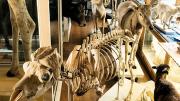The Great Mammal Hall, a two-story gallery 60 feet long by 40 wide, is the oldest and most dramatic in the Harvard Museum of Natural History (HMNH). The hall was emptied of its taxonomic treasures as part of a renovation commemorating the 150th anniversary of the founding of the Museum of Comparative Zoology: the animals were removed and repaired and the display cases restored to their nineteenth-century colors, replacing a palette dating to the 1960s. The gallery reopened October 16. Above, a gaur noses into the stream of escapees during the renovation.
Great Mammal Hall at Harvard Museum of Natural History reopens
Great Mammal Hall at Harvard Museum of Natural History reopens
The Great Mammal Hall in the Harvard Museum of Natural History is restored and reopened.

You might also like
Trump Administration Appeals Order Restoring $2.7 Billion in Funding to Harvard
The appeal, which had been expected, came two days before the deadline to file.
At Harvard, AI Meets “Post-Neoliberalism”
Experts debate whether markets alone should govern tech in the U.S.
Sam Liss to Head Harvard’s Office for Technology Development
Technology licensing and corporate partnerships are an important source of revenue for the University.
Most popular
Explore More From Current Issue

This TikTok Artist Combines Monsters and Mental Heath
Ava Jinying Salzman’s artwork helps people process difficult feelings.

Novelist Lev Grossman on Why Fantasy Isn’t About Escapism
The Magicians author discusses his influences, from Harvard to King Arthur to Tolkien.

Introductions: Dan Cnossen
A conversation with the former Navy SEAL and gold-medal-winning Paralympic skier





